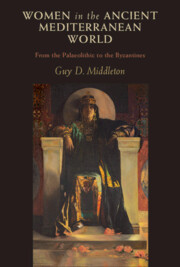Book contents
- Women in the Ancient Mediterranean World
- Women in the Ancient Mediterranean World
- Copyright page
- Dedication
- Epigraph
- Contents
- Preface
- Acknowledgements
- Timeline
- Historical Contexts
- Introduction
- Part I The Deep Past
- Part II The Bronze Age
- Part III The Iron Age
- 12 Naunakhte
- 13 Herse
- 14 Pkpupes
- 15 Atossa
- 16 The Princess of Vix
- 17 Aristonice
- 18 Neaira
- 19 Phanostrate
- Part IV The Hellenistic Worlds
- Part V The Age of Empire
- Notes
- Select Bibliography
- Index
17 - Aristonice
from Part III - The Iron Age
Published online by Cambridge University Press: 19 January 2023
- Women in the Ancient Mediterranean World
- Women in the Ancient Mediterranean World
- Copyright page
- Dedication
- Epigraph
- Contents
- Preface
- Acknowledgements
- Timeline
- Historical Contexts
- Introduction
- Part I The Deep Past
- Part II The Bronze Age
- Part III The Iron Age
- 12 Naunakhte
- 13 Herse
- 14 Pkpupes
- 15 Atossa
- 16 The Princess of Vix
- 17 Aristonice
- 18 Neaira
- 19 Phanostrate
- Part IV The Hellenistic Worlds
- Part V The Age of Empire
- Notes
- Select Bibliography
- Index
Summary
At the heart of ancient Greece lay a small city perched on a mountainside – Delphi.1 At the heart of Delphi was the temple of Apollo, where delegations from cities far and wide, even beyond Greece, would come for answers and advice. And at the heart of the temple was a woman, the Pythia, the priestess of Apollo and mouthpiece of the god (Figure 17). For a thousand years successive Pythias occupied this position as ‘the voice at the center of the world’, until the oracles eventually ran dry in the fourth century and then pagan cults were outlawed by the Roman emperor Theodosius in the ad 390s.2 Around 480 bc, the Pythia was a woman called Aristonice. Her words have reverberated through western history.
- Type
- Chapter
- Information
- Women in the Ancient Mediterranean WorldFrom the Palaeolithic to the Byzantines, pp. 143 - 148Publisher: Cambridge University PressPrint publication year: 2023

